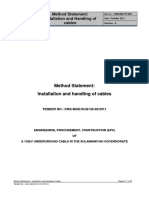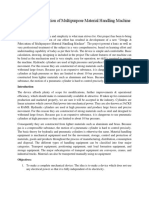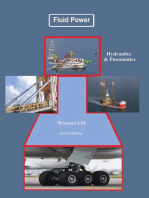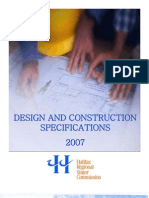Design and Finite Element Analysis of Do
Uploaded by
توت خطريDesign and Finite Element Analysis of Do
Uploaded by
توت خطريSee discussions, stats, and author profiles for this publication at: https://www.researchgate.
net/publication/315658107
Design and Finite Element Analysis of Double - Acting, Double - Ends
Hydraulic Cylinder for Industrial Automation Application
Article · March 2017
CITATIONS READS
11 7,494
3 authors:
Thankgod E. Boye Olabisi Ibukun Adeyemi
University of Southampton / Federal University of Petroleum Resources The University of Warwick
26 PUBLICATIONS 113 CITATIONS 13 PUBLICATIONS 195 CITATIONS
SEE PROFILE SEE PROFILE
Eyere Emagbetere
Federal University of Petroleum Resources
44 PUBLICATIONS 97 CITATIONS
SEE PROFILE
Some of the authors of this publication are also working on these related projects:
Design, Construction and Testing of a Prototype Energy Efficient Eco-Marathon Vehicle powered by Gasoline View project
Bio-wastes-based Composite Friction Materials View project
All content following this page was uploaded by Thankgod E. Boye on 31 August 2020.
The user has requested enhancement of the downloaded file.
American Journal of Engineering Research (AJER) 2017
American Journal of Engineering Research (AJER)
e-ISSN: 2320-0847 p-ISSN : 2320-0936
Volume-6, Issue-3, pp-131-138
www.ajer.org
Research Paper Open Access
Design and Finite Element Analysis of Double - Acting, Double -
Ends Hydraulic Cylinder for Industrial Automation Application
ThankGod E. Boye, Adeyemi, I. Olabisi,Eyere E. Emagbetere3
(Department of Mechanical Engineering, Federal University of Petroleum Resources, Effurun, Nigeria)
ABSTRACT: The design and analysis of safe hydraulic cylinders have become a great concern because of the
important role it plays in the automation of industrial equipment and systems. Hydraulic and pneumatic systems
are fluid power systems that are commonly used in the industry nowadays. Most failures experienced in
hydraulic systems are failures associated with the linear actuator (hydraulic cylinder). Most of these failures
are design, materials and structural integrity related one whereby safety standards are not fully satisfied. This
paper address the issue of deploying and implementation of acceptable design codes for the design and
structural analysis of a double acting double ends hydraulic cylinder basically for industrial automation
applications. The maximum force is estimated to be 11 KN. The combination of Analytical and finite element
analysis (FEA) methods was utilized for the development of the cylinder. These are to give credibility to the
design for the purpose of future manufacture of the cylinder. The bursting pressure, longitudinal stress piston
rod and piston diameter, barbell thickness was determined and analyzed. The methods used for this design work
could provide significant knowledge and skill for young design engineers, and this cylinder product may be
readily available to industrialist for manufacture.
Keywords: Design, Hydraulics, Cylinder, Industrial, and Automation
I. INTRODUCTION
Over the years, man has recognized and accepted fluid as a source of power. Hydraulic power has been
used over the years as the primary source of power to propel boats and turn water wheels.However hydraulic has
found greater applications today more than its initial use as it has gained more acceptability in different fields. It
is now used on land moving vessels, in the aviation industry, process automation, robotics and very numerous
engineering branches. Now it is known traditionally as force transmission through pressurized fluids. Hydraulic
power came into existence in 1648 when a Frenchman named Pascal made a publication on hydrostatics, which
included his law that stated that pressure in a fluid is transmitted equally in all directions [2]. This principle was
later used to generate fluid force in the industry, not just water alone as in the Bramah’s press [2]. Bramah was
able to demonstrate that a small force on a long stroke, small diameter piston could produce a relatively large
force on a short stroke, large diameter piston. This force amplification was very impressive. However, his
observation that there was a way to transmit power, as well as the force, was more important because he showed
a way to change power from mechanical to hydraulic and then back to mechanical very efficiently [1].
Fundamentally, every hydraulic system should in its basic form consist of a reservoir, valves, pipe
hoses, and actuators. The reservoir contains fluid, a pump or motor which pressurizes this fluid in the hydraulic
system. The Valves are responsible for the control of fluid flow and pressure in the system. The pipes or hoses
transmits fluid with or without pressure to the desired parts of the system. The actuators (also called hydraulic
cylinders) are used to convert the fluid energy to mechanical energy that can be used to do work [6, 10]. The
output power developed always depends on the flow rate, the pressure drop and accompanying velocity increase
across the actuator and its overall efficiency.
Figure 1: Schematic showing the main components of a hydraulic system [5].
www.ajer.org Page 131
American Journal of Engineering Research (AJER) 2017
Seeing, therefore, the importance of hydraulic cylinders in hydraulic systems, over the years there has
been deliberate efforts to develop the different types of cylinders.Apart from the telescopic and tandem
cylinders, it has the single acting and double acting hydraulic cylinders which are very efficient and may be used
based on the desired application. Double-acting hydraulic cylinders are of two types as well, the Double - acting
hydraulics cylinder with piston rod on one end and Double - acting hydraulic cylinder with piston rod on both
ends which will be the focus of this work. This research work used a CAD tool (Solidworks) to carry out finite
element analysis (FEA) on a typical double acting hydraulic cylinder with double ends that can withstand a
pressure of 200 bars and produce a force of up to 11kN.
II. MATERIALS AND METHODS
The For this research work, the materials adopted include a high-speed computer and a CAD- tool
(Solidworks) used for the simulation and FEA [8, 9]. The figure below shows the procedure followed in the
carrying out of this study.
2.1 Double acting double ends hydraulic cylinders.
Double acting cylinders are normally designed such that pressure can be applied in either inlet or outlet
port, providing linear power in both directions [11]. Furthermore, since the exposed areas in the cylinder are
unequal during extract and retract operations (forward and return stroke) there is a difference in operation speed
and force.The double acting double ends hydraulic cylinder which is the subject of this research is not in any
sense different in principle of operation from every normal hydraulic cylinder but it produces both fluid flow
and pressure in both directions, and both ends of the piston can be connected to the point of application where
work is needed to be done.
2.2 Parts design consideration
The following assumptions were taken into the consideration of the design of the cylinder, piston, piston rod and
seals in the hydraulic cylinder.
Working fluid is mineral oil
Available pressured Pa =200bar= 200* 105pa
Atmospheric pressure = 1.0135 * 105pa
Stroke length= 60mm+80mm =140mm = 0.14m
Cylinder output force =11KN = 11000N
Cutting stroke=1.5m/s
Material for cylinder calculation low carbon steel BS970 070M20
Tensile stress of material is = 430mPa
Yield stress of material is = 215mPa
Factor of safety = 3
Young modulus of the material used is = 210GPa, for BS 970 070M20 (low carbon steel)
End fixing factor = K = 0.7 is chosen because of maintenance purpose, in a case of adjustment i.e. in the
case of increasing stroke length.
2.2.1 Design of piston rod
The piston rod of a hydraulic cylinder is highly stressed, and therefore it should be able to resist the
bending, tensile and compressive forces that it may encounter during the operation without buckling. In practice,
the rod is more likely to fail by buckling under the compressive load than by bending. In this case, the rod
behaves like a column and is subjected to buckling. The rod diameter can be related to critical load. Therefore
Euler’s formula in the equation below for long column can be used to obtain the piston rod diameter.
Where:
P = Buckling load (N)
L = the column length (m)
I = Moment of inertia (m4)
E = Young's Modulus of Elasticity for the column material (Pa)
K = the end fixing factor
E = Young’s modulus of the material used in this design calculation is 210 (Gpa) for BS 970 070M20 (Low
carbon steel).
P = cylinder force * factor of safety = 11000 * 3 = 33 * 103N
L = total stroke length =140mm = 0.14m
K = 0.7, Reason for choosing k = 0.7 is for maintenance purposes in case of adjustment i.e. in case of increase in
the stroke length of the rod.
Substitute into the equation 2.1
www.ajer.org Page 132
American Journal of Engineering Research (AJER) 2017
The moment of inertia and the maximum permissible stress to avoid buckling is dependent on the type of end
fixing of the cylinder. The moment of inertia (I) can be found from the formula below
Therefore:
Making d4 the subject we have
Hence diameter of the piston rod required, d = 8 mm. Finally, for other calculations and in a case of
construction, the diameter of the piston rod used will be 12mm, for safety and because from Baym Hydraulics
Corporation catalog of metric rod wipers and piston seals the nearest standard rod seal diameter is 12mm.
2.2.2 Design of the piston
The hydraulic piston design must not be complicated. It must be designed for ease of assembly and
disassembly for maintenance purposes. A study was done to find out if a solid piston can withstand the
compressive force that a piston rod is subjected to. The main failure point was the edges of the piston and kind
of seals used at tolerances between the piston and the cylinder wall. They all have minimum factor of safety of
3. Let A be the full area of the piston and a be the cross sectional area of the piston rod. Since the design is a
double acting double ended hydraulic cylinder, pressure is acts on both sides of the rod, hence the area which
the pressure is acting on is given by (A-a). The force produced is given in the equation below.
Since the piston and the piston rod are circular in nature, therefore area of the pressurized part is given by
(4)
Where:
F = force = assume force * factor of safety (3) = 11000 * 3 = 33 * 10 3N
P = pressure, 200bar = 200 * 105 Pa
D = diameter of piston
d =diameter of piston rod, 12mm = 0.012m
By substituting the above value into those equations, we have,
m
Hence diameter of piston required d = 47 mm. Finally, for other calculations and construction, the diameter of
the piston is taken to be 48mm. Because from Baym Hydraulics Corporation catalog of metric rod wipers and
piston seals, the nearest standard rod seal diameter is 48mm.
2.2.3 Design of the cylinder
Let OD = outside diameter of the cylinder.
Tensile stress of BS 970 070M20 = 430mpa
Factor of safety (N) = 3
Determine the maximum working stress (σ m) is given as
σm= =
6
σm = 143.3 * 10 pa
Applying lame’s equation to determine OD
OD2 =
OD2 =
OD = 0.055m = 55mm
2.2.3.1 Cylinder Tube thickness
The tube thickness of a cylinder barrel is a very important factor in the design of a hydraulic cylinder. The
strength of the cylinder tube is proportional to its wall. If a cylinder is too thick or too thin may pose serious
www.ajer.org Page 133
American Journal of Engineering Research (AJER) 2017
safety, and operational problems and hence the tube thickness of the cylinder has to be carefully chosen. The
wall thickness required for the cylinder can be calculated from the formula in equation (3.9).
Thickness (t) =
Where:
OD, is the cylinder external diameter, 55mm and small “d” is the piston seal diameter (cylinder internal
diameter), 48mm.
t=
Thickness (t) = 3.5mm
2.2.4 Bursting stress
To determine the bursting stress of the cylinder we need to apply lame’s equation for thick cylinder because
the ratio of inside diameter t/d is > 1/20.
When a thick-walled tube or cylinder is subjected to internal and external pressures, hoop and longitudinal
stresses act on the wall.
The bursting stress can be referred to as the amounts of hoop stress and longitudinal (axial) stress that are
produced in the wall of the cylinder when subjected to internal and external pressures that may cause the
material which the cylinder is made from to fail. This happens if the hoops stress exceeds the tensile
strength of the material.
In this design calculation, the hoop stress must be lower than a tensile strength of the material which the
cylinder is made from to ensure the safety of the cylinder and personnel during actual operation.
Material of the cylinder BS 970 070M20 (low carbon steel) Tensile stress = 430 * 106pa. The hoop stress ( )
of a cylinder can be determined from the Barlow formula as shown in the equation below.
Where:
p= oil pressure, 200bar = 200 * 105Pa
do= outer diameter of cylinder, 55mm
di = inner diameter of cylinder, 48mm
Substituting into equation 10
Pa
Also the longitudinal stress is given by:
P1 R 1 P 2 R 2
2 2
(8 )
R 2 R1
2 2
=
Where P1 = Internal pressure (200 * 105pa)
P2 = External pressure (atmospheric pressure = 1.0135 * 10 5pa)
R1 = Internal radius
R2 = External radius
Therefore;
= 63.4 * 106Pa
= 63.4 Mpa.
2.3 Material for the hydraulic cylinder
In the design of mechanical systems, the choice of material plays a huge role in the functionality of the
system. There are various types of materials used for constructing hydraulic cylinder, and the selection largely
depends on the requirement of the hydraulic cylinder. But in the case of this research, low carbon steel (BS 970
070M20) as shown in was chosen as the material for the hydraulic cylinder because it combines the required
light weight with very good yield strength, tensile strength, corrosion resistance and good surface hardness for
wear resistance.
It has minimum yield strength of 215 Mpa, minimum tensile strength 430 Mpa, 21% elongation, with a
composition of 0.2% of carbon(c) and 0.7% of manganese (Mn) and normalized condition. BS 970 070M20 is a
very common form of steel because of its low price and its acceptable material properties notwithstanding. It is
neither brittle nor ductile and low carbon steel has a relatively low tensile strength, but it is cheap and malleable.
Its surface hardness can be improved by carburizing. It is mostly used for large quantity needs, for example,
www.ajer.org Page 134
American Journal of Engineering Research (AJER) 2017
structural steel. The density of low carbon steel has been found to be approximately 7.85g/cm 3, and Young's
modulus is 210,00Mpa.
The material chosen will be used for the construction of the hydraulic cylinder components such as the
cylinder, piston rod, piston, the end caps and tie rods. The method adopted for the selection of the material was
from (Materials selection in mechanical design, Prof. M F Ashby.) First and foremost, it took into account the
basic parameters of Materials selection in mechanical design-which are, strength, toughness, and weight. The
basic function for designing the system (double acting double ends hydraulic cylinder) is for it to be able to
produce a shearing force from 10KN to 11KN and that velocity of cutting stroke should not exceed 1.5m/s. The
Constraint of the cylinder is the performance and limiting factor i.e. strength of the material BS 970 070 M20
(low carbon steel) -if it can be able to withstand the high pressures built up inside the cylinder.
2.4 Finite element analysis (FEA) of the hydraulic cylinder
The initial design of the cylinder was made of paper with sketches and with design calculations
provided. The various parts/components were reproduced using Solidworks. These components were then fitted
together in an assembly to make sure they fit together and that the required motion trajectories were possible
without problems. Static simulations were done on the key parts to make sure they would be able to handle the
maximum stresses during operation and to help in optimizing weight. The analysis was also used to verify the
rate of deformation and principal stresses acting on each component. A safety factor of 3 was used for the
design. This was done because the stresses are well defined, and weight of the assembly was very important.
The requirement for low weight was the biggest reason for not using a larger safety factor.
III. RESULTS AND DISCUSSION
The All the components and parts of the double acting double-end hydraulic cylinder were carefully
developed and modeled using Solidworks workspace. The 3D models of the parts and the pictorial simulation
results for both the stress analysis and deformation will be represented below.
Figure 2: Piston and piston rod configuration.
Figure 3: Deformation of piston and piston rod assembly under maximum load of 11kN.
www.ajer.org Page 135
American Journal of Engineering Research (AJER) 2017
Figure 4: Stress analysis for piston and piston rod under maximum load of 11kN.
Figure 5: Deformation tests under 11kN force
Figure 6: Stress test on flange 11kN force under static simulation.
www.ajer.org Page 136
American Journal of Engineering Research (AJER) 2017
Figure 7: Deformation analysis of cylinder with 200bar internal pressure.
Figure 8:Stress analysis of cylinder under 200bar internal pressure.
A 3D model of a double acting double ends hydraulic cylinder with the following specifications was
designed usingBS 970 070M20 (Low carbon steel) and from the simulation results as can be seen in fig. 8 even
when subjected to an internal pressure of 200bar, the maximum stress experienced at the ends will be way less
than the yield strength of the material. It can as well be seen from the stress analysis results that the von Mises
stress on both the flange and piston and piston rod assembly do not exceed the yield strength of BS 970 070M20
(Low carbon steel). This implies that using this material with the following specifications will yield optimum
results without failure. The results can as well be extrapolated.
Table 1
S/N PARTSDIMENSION SYMBOL VALUES UNIT
1 Piston rod diameter D 12 mm
2 Piston diameter D 48 mm
3 Cylinder Outside diameter OD 55 mm
4 Cylinder wall thickness T 3.5 mm
5 Stroke length L 140 mm
6 Cylinder port diameter _ 10 mm
7 Width of cylinder end flange _ 75 mm
8 Length of cylinder flange _ 30 mm
9 Tie rod diameter On flange _ 8 mm
10 Flange Edge fillet radius _ 3 mm
11 Cylinder port diameter _ 10 mm
12 Length of tie rod _ 220 mm
13 Hoop stress 147.8 mm
14 Longitudinal stress 63.4 mm
15 Extension/retractionforce F 11000 N
16 Pressure P 200 Bar
www.ajer.org Page 137
American Journal of Engineering Research (AJER) 2017
IV. CONCLUSION
A double acting double ends hydraulic cylinder was successfully designed and analyzed. Relevant
standards and codes were used in the material selection process, and choosing of seals also follows. Therefore
the design of double acting double end hydraulic cylinder was achieved and is ready for manufacturing. The
cylinder external and internal diameters were determined to be 55mm, and 48mm, piston diameter with a seal is
48mm, piston rod diameter is 12mm and the stroke length is 140mm. The FEA analysis carried out on the
hydraulic cylinder provided credible validation for the reliability, functionality, and safety of the hydraulic
cylinder designed.This designed double acting double end hydraulic cylinder can be effective employed when
manufactured for industrial automation such as hydraulics system for cutting and crimping of hydraulics pipe
hoses, power steering for earth moving vehicles among others industrial applications.
REFERENCES
[1] Willian E. Hurst, Piezo-Hydraulic actuator Design, and Modeling Using Lumped Parameter Approach. M.S Thesis Virginia
Polytechnic Institute and State University, 2002.
[2] Izzettin Osman Egüz,Hydraulic Press Construction for Fitting the Bearing to a Housing,Vaxjo University School of Technology
and Design SE- 351 95 Växjö Sweden, 2008.
[3] Ashby F.M and Jones, R.B.H., Engineering Material: An introduction to their properties and application (2nd Edition), Oxford
Butter Worth Heinmann, 2002..
[4] Parker, Series of MH Hydraulic Heavy Duty Mill Cylinder. Parker Hannifin Corporation, motion and Control Division 160 Chishom
Drive Milton, 2008.
[5] William Durfee, Zongxuan Sun and James Van de Ven, Fluid Power System Dynamics,Center for Compact and Efficient Fluid
Power University of Minnesota Minneapolis, USA 2015.
[6] CHEN, Luo, and Ji-zhao LIANG. "Application of complex method in optimal design of hydraulic cylinder supported with flange
[J]." Machinery Design & Manufacture 3, 2010): 038.
[7] Tenalli V. S. Simulation of Electro Hydraulic Servo Actuator.M S. thesis Department of mechanical engineering national institute of
Technology, rourkela. Rourkela 2012.
[8] RavishankarN., Finite Element Analysis of Hydraulic Cylinders.Journal Mech. Des 103(1), 239-243, 1981
[9] Ţălu D.L.Mihai1, Ţălu D.L. Ştefan, A Finite Element Analysis Of Hydraulic Cylinder Of Linear Hydraulic Motor From Horizontal
Hydraulic Press – 2 Mn, Journal of Engineering Studies and Research – Volume 16 (2010) No. 4 pp.59-62
[10] JayantSirohi, Inderjit Chopra, Design and Development of a High Pumping Frequency PiezoelectricHydraulic Hybrid
ActuatorJournal of Intelligent Material Systems and StructuresVol. 14, Issue 3, 2003.
[11] Ross Henderson, Design, simulation, and testing of a novel hydraulic power take-off system for the Pelamis wave energy converter,
Renewable Energy 31 (2006) 271–283
www.ajer.org Page 138
View publication stats
You might also like
- 1-Method Statement-Installation and Handling of CablesNo ratings yet1-Method Statement-Installation and Handling of Cables27 pages
- 01.28.19 Bom - Boq 4TH Floor Emapta Office Fitout - Ee, Mech, Plum & Structured CablingNo ratings yet01.28.19 Bom - Boq 4TH Floor Emapta Office Fitout - Ee, Mech, Plum & Structured Cabling10 pages
- Soundless Chemical Demolition Agents at Site For Demolishing ConcreteNo ratings yetSoundless Chemical Demolition Agents at Site For Demolishing Concrete22 pages
- Journal of Information, Knowledge and Research inNo ratings yetJournal of Information, Knowledge and Research in3 pages
- Acknowledgement: Chitkara Institute of Engineering and TechnologyNo ratings yetAcknowledgement: Chitkara Institute of Engineering and Technology16 pages
- Design and Fabrication of A Manually Operated Hydraulic PressNo ratings yetDesign and Fabrication of A Manually Operated Hydraulic Press10 pages
- Introduction To Pneumatics and HydydraullicsNo ratings yetIntroduction To Pneumatics and Hydydraullics20 pages
- Title Page No.: Declaration I Acknowledgement II List of Abbreviations III List of Figures and Tables IVNo ratings yetTitle Page No.: Declaration I Acknowledgement II List of Abbreviations III List of Figures and Tables IV14 pages
- 36.Fluid Power Systems in Mechanical Engineering Hydraulics and PneumaticsNo ratings yet36.Fluid Power Systems in Mechanical Engineering Hydraulics and Pneumatics8 pages
- Hydraulic Cylinders: Profile No.: 167 NIC Code:28199100% (1)Hydraulic Cylinders: Profile No.: 167 NIC Code:2819912 pages
- Design and Manufacture of A 30-Ton Hydraulic Press: February 2011No ratings yetDesign and Manufacture of A 30-Ton Hydraulic Press: February 20116 pages
- Design and Fabrication of Hydraulic Zig Zag Bending MachineNo ratings yetDesign and Fabrication of Hydraulic Zig Zag Bending Machine46 pages
- DesignandFabricationofH TypeVerticalHydraulicPressNo ratings yetDesignandFabricationofH TypeVerticalHydraulicPress7 pages
- Design and Development of Pneumatic Lab Activities For A Course On Fluid PowerNo ratings yetDesign and Development of Pneumatic Lab Activities For A Course On Fluid Power35 pages
- Design Optimization of Hydraulic Press Plate Using Finite Element AnalysisNo ratings yetDesign Optimization of Hydraulic Press Plate Using Finite Element Analysis9 pages
- Fabrication and Review of Hydraulic Heavy Sheet Metal Cutting MachineNo ratings yetFabrication and Review of Hydraulic Heavy Sheet Metal Cutting Machine5 pages
- Unit - 1 Hydraulic and Pneumatic SystemsNo ratings yetUnit - 1 Hydraulic and Pneumatic Systems44 pages
- Chapter-1 Introduction To Project PlanningNo ratings yetChapter-1 Introduction To Project Planning32 pages
- A Desing of Fuel Injection Pipe Head Forming MachineNo ratings yetA Desing of Fuel Injection Pipe Head Forming Machine9 pages
- Lecture 1- Introduction to Hydraulic And Pneumatic SystemsNo ratings yetLecture 1- Introduction to Hydraulic And Pneumatic Systems32 pages
- Methodologies for Assessing Pipe Failure Rates in Advanced Water Cooled ReactorsFrom EverandMethodologies for Assessing Pipe Failure Rates in Advanced Water Cooled ReactorsNo ratings yet
- Energy Storage in Grids with High Penetration of Variable GenerationFrom EverandEnergy Storage in Grids with High Penetration of Variable GenerationNo ratings yet
- Petronas Technical Standards: Pipeline and Riser Engineering DesignNo ratings yetPetronas Technical Standards: Pipeline and Riser Engineering Design37 pages
- x800 xs2 Water-Resistant Connectors m12 Datasheet enNo ratings yetx800 xs2 Water-Resistant Connectors m12 Datasheet en35 pages
- 2021.08.01 - 100 - Concept Report - 2.5 Apt - JVC 11No ratings yet2021.08.01 - 100 - Concept Report - 2.5 Apt - JVC 1115 pages
- Sustainability Approach With Digital Construction-Amy R. WidyastutiNo ratings yetSustainability Approach With Digital Construction-Amy R. Widyastuti28 pages
- Product Data: 19XR Positive Pressure Storage SystemNo ratings yetProduct Data: 19XR Positive Pressure Storage System12 pages
- Beekeeping With The Warré Hive - Plans For Constructing A Warré Hive20130812065811No ratings yetBeekeeping With The Warré Hive - Plans For Constructing A Warré Hive201308120658118 pages
- Determination of AASHTO Layer Coefficients For Granular MaterialsNo ratings yetDetermination of AASHTO Layer Coefficients For Granular Materials12 pages
- C110-M433.01 - Rev. G - Chilled Water Piping Schematic DiagramNo ratings yetC110-M433.01 - Rev. G - Chilled Water Piping Schematic Diagram7 pages
- Guncrete: High Strength, Low Shrinkage, High Build Spray Applied Repair MortarNo ratings yetGuncrete: High Strength, Low Shrinkage, High Build Spray Applied Repair Mortar4 pages
- Department of Civil Engineering: Application of 3-D Printing in ConstructionNo ratings yetDepartment of Civil Engineering: Application of 3-D Printing in Construction16 pages
- Raker-Beam Construction Requires Rugged Steel Forms - tcm45-3431230% (1)Raker-Beam Construction Requires Rugged Steel Forms - tcm45-3431234 pages
- 1-Method Statement-Installation and Handling of Cables1-Method Statement-Installation and Handling of Cables
- 01.28.19 Bom - Boq 4TH Floor Emapta Office Fitout - Ee, Mech, Plum & Structured Cabling01.28.19 Bom - Boq 4TH Floor Emapta Office Fitout - Ee, Mech, Plum & Structured Cabling
- Soundless Chemical Demolition Agents at Site For Demolishing ConcreteSoundless Chemical Demolition Agents at Site For Demolishing Concrete
- Acknowledgement: Chitkara Institute of Engineering and TechnologyAcknowledgement: Chitkara Institute of Engineering and Technology
- Design and Fabrication of A Manually Operated Hydraulic PressDesign and Fabrication of A Manually Operated Hydraulic Press
- Title Page No.: Declaration I Acknowledgement II List of Abbreviations III List of Figures and Tables IVTitle Page No.: Declaration I Acknowledgement II List of Abbreviations III List of Figures and Tables IV
- 36.Fluid Power Systems in Mechanical Engineering Hydraulics and Pneumatics36.Fluid Power Systems in Mechanical Engineering Hydraulics and Pneumatics
- Hydraulic Cylinders: Profile No.: 167 NIC Code:28199Hydraulic Cylinders: Profile No.: 167 NIC Code:28199
- Design and Manufacture of A 30-Ton Hydraulic Press: February 2011Design and Manufacture of A 30-Ton Hydraulic Press: February 2011
- Design and Fabrication of Hydraulic Zig Zag Bending MachineDesign and Fabrication of Hydraulic Zig Zag Bending Machine
- DesignandFabricationofH TypeVerticalHydraulicPressDesignandFabricationofH TypeVerticalHydraulicPress
- Design and Development of Pneumatic Lab Activities For A Course On Fluid PowerDesign and Development of Pneumatic Lab Activities For A Course On Fluid Power
- Design Optimization of Hydraulic Press Plate Using Finite Element AnalysisDesign Optimization of Hydraulic Press Plate Using Finite Element Analysis
- Fabrication and Review of Hydraulic Heavy Sheet Metal Cutting MachineFabrication and Review of Hydraulic Heavy Sheet Metal Cutting Machine
- A Desing of Fuel Injection Pipe Head Forming MachineA Desing of Fuel Injection Pipe Head Forming Machine
- Lecture 1- Introduction to Hydraulic And Pneumatic SystemsLecture 1- Introduction to Hydraulic And Pneumatic Systems
- Methodologies for Assessing Pipe Failure Rates in Advanced Water Cooled ReactorsFrom EverandMethodologies for Assessing Pipe Failure Rates in Advanced Water Cooled Reactors
- Energy Storage in Grids with High Penetration of Variable GenerationFrom EverandEnergy Storage in Grids with High Penetration of Variable Generation
- Petronas Technical Standards: Pipeline and Riser Engineering DesignPetronas Technical Standards: Pipeline and Riser Engineering Design
- x800 xs2 Water-Resistant Connectors m12 Datasheet enx800 xs2 Water-Resistant Connectors m12 Datasheet en
- 2021.08.01 - 100 - Concept Report - 2.5 Apt - JVC 112021.08.01 - 100 - Concept Report - 2.5 Apt - JVC 11
- Sustainability Approach With Digital Construction-Amy R. WidyastutiSustainability Approach With Digital Construction-Amy R. Widyastuti
- Product Data: 19XR Positive Pressure Storage SystemProduct Data: 19XR Positive Pressure Storage System
- Beekeeping With The Warré Hive - Plans For Constructing A Warré Hive20130812065811Beekeeping With The Warré Hive - Plans For Constructing A Warré Hive20130812065811
- Determination of AASHTO Layer Coefficients For Granular MaterialsDetermination of AASHTO Layer Coefficients For Granular Materials
- C110-M433.01 - Rev. G - Chilled Water Piping Schematic DiagramC110-M433.01 - Rev. G - Chilled Water Piping Schematic Diagram
- Guncrete: High Strength, Low Shrinkage, High Build Spray Applied Repair MortarGuncrete: High Strength, Low Shrinkage, High Build Spray Applied Repair Mortar
- Department of Civil Engineering: Application of 3-D Printing in ConstructionDepartment of Civil Engineering: Application of 3-D Printing in Construction
- Raker-Beam Construction Requires Rugged Steel Forms - tcm45-343123Raker-Beam Construction Requires Rugged Steel Forms - tcm45-343123

























































































